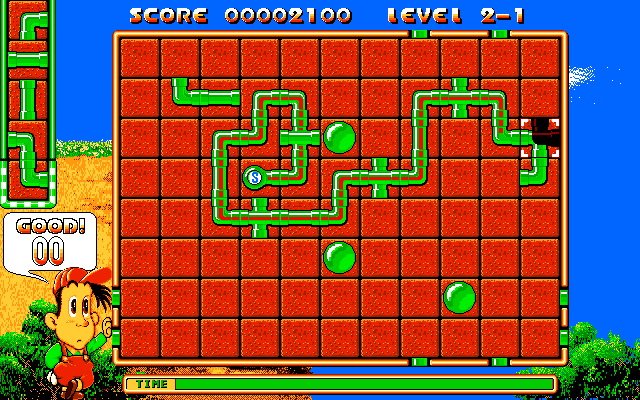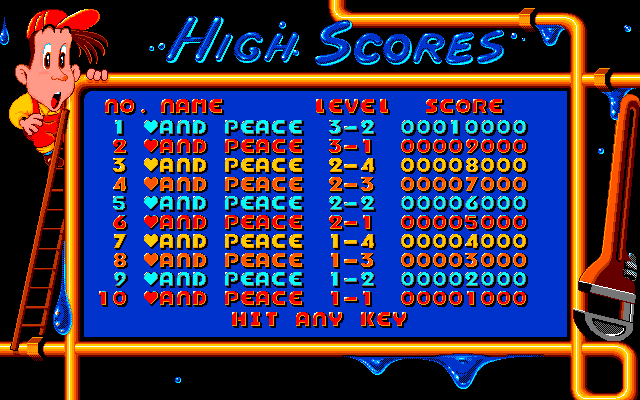Retro Replay Review
Gameplay
Pipe Dream offers a compelling blend of strategy and quick thinking as you race against time to lay out an intricate network of pipes. Each level tasks you with guiding the mysterious “flooz” substance through as many pipe segments as possible before it leaks into empty space or hits an ill-fitting joint. The randomness of piece selection keeps you on your toes, ensuring that no two runs feel the same and demanding adaptability at every turn.
(HEY YOU!! We hope you enjoy! We try not to run ads. So basically, this is a very expensive hobby running this site. Please consider joining us for updates, forums, and more. Network w/ us to make some cash or friends while retro gaming, and you can win some free retro games for posting. Okay, carry on 👍)
The core mechanic revolves around seven distinct pipe shapes—horizontal, vertical, four corner rotations, and crossovers—and each piece can be entered from either side. Before the flooz starts flowing, you’re granted a brief planning window to place initial segments anywhere on the board. This phase can feel almost meditative as you envision your piping labyrinth, but once the flooz begins, decisions must be instantaneous to prevent early termination.
When you do encounter gaps within your network, Pipe Dream lets you swap out an existing piece for a new one, albeit at the cost of a small score penalty. This dynamic replacement mechanic introduces tension: do you risk the penalty to maintain flow, or accept an early end to keep your score pristine? Balancing these split-second judgments is where the game truly shines.
Bonus objectives inject further depth into the formula. Looping the flooz through both sides of at least five crossover pieces or filling every tile on the board yields hefty point rewards. As you progress, obstructed tiles and side-wall openings spice up familiar grids, and every fourth level launches you into a Connect-4-style mini-game. This cyclical rhythm of pure puzzle levels and bonus rounds maintains a steady tempo that both challenges and refreshes.
Graphics
Pipe Dream embraces a clean, minimalistic aesthetic that prioritizes clarity over flashiness. Pipes are rendered in crisp, easily distinguishable colors with subtle shading, ensuring you can spot the perfect piece at a glance—even as the flooz speeds up. This no-frills visual design keeps the focus squarely on the puzzle at hand.
The UI elements are unobtrusive yet informative. Score tallies, next-piece previews, and time indicators are placed around the board’s perimeter, allowing you to monitor your performance without cluttering the central play area. The pipe pieces themselves animate smoothly as they lock into position, and the flooz flows with a satisfying transparency and shine that makes every last drop visually rewarding.
Backgrounds are deliberately muted, employing soft gradients and simple geometric patterns that never compete with the gameplay. This restrained approach not only reduces visual fatigue during marathon sessions but also reinforces the abstract, almost industrial atmosphere of guiding a mysterious substance through your handcrafted conduits.
While modern titles might boast high-definition textures or 3D models, Pipe Dream’s timeless 2D style is a strength rather than a weakness. Its straightforward presentation scales effortlessly across platforms and resolutions, making it equally at home on both retro-inspired handhelds and widescreen desktops.
Story
In a genre often dominated by sprawling narratives or character-driven arcs, Pipe Dream takes a different route: there is no explicit backstory, cast of characters, or overarching plot. Instead, the game invites players to immerse themselves purely in the act of problem-solving. This absence of narrative can feel refreshingly direct, letting you focus entirely on the puzzle’s elegant mechanics.
That said, a minimal thematic thread is woven through the idea of the “flooz,” a mysterious fluid with no defined purpose beyond testing your piping prowess. Its undefined nature adds a subtle layer of intrigue—are you delivering fuel to a distant colony, or simply running maintenance on a labyrinthine conduit system? The game leaves this open to interpretation, which can be oddly satisfying.
For players who crave context or character progression, Pipe Dream may seem sparse. There are no animated cutscenes, no NPC dialogue, and no dramatic twists in the later levels. However, this narrative blank canvas can actually be empowering: each player becomes the architect of their own story through every successful network and high-scoring run.
Ultimately, Pipe Dream’s lack of a traditional storyline doesn’t feel like a drawback but rather a deliberate design choice that complements its puzzle-centric focus. It’s less about where you’re going and more about how elegantly you can get there.
Overall Experience
Pipe Dream delivers an addictive puzzle experience that deftly balances challenge and accessibility. The initial ease of placing basic straight pipes gradually gives way to tighter time constraints and more complex layouts, ensuring that even seasoned veterans will find fresh obstacles to overcome. The inclusion of bonus rounds further diversifies the pacing, preventing the core gameplay loop from ever growing stale.
While the abstract visuals and absence of a traditional story might not appeal to every gamer, those who appreciate pure, unadulterated puzzle design will find themselves completely absorbed. The game’s randomized piece order and scoring penalties for swapping inject unpredictability, coaxing players back for just one more attempt to beat their personal best.
Pipe Dream shines as both a casual time-killer and a deep puzzle challenge. Short play sessions feel rewarding thanks to the quick level times, yet extended runs reveal the layers of strategic depth hidden beneath its deceptively simple premise. Whether you’re a veteran puzzle fiend or a newcomer looking for a brain-teasing diversion, there’s plenty here to keep your mind engaged.
In the end, Pipe Dream stands as a testament to elegant design: no overly flashy trappings, just a pure test of spatial reasoning and split-second decision-making. Its straightforward mechanics, coupled with a finely tuned difficulty curve, make it a must-play for anyone seeking an enduring puzzle experience.
 Retro Replay Retro Replay gaming reviews, news, emulation, geek stuff and more!
Retro Replay Retro Replay gaming reviews, news, emulation, geek stuff and more!









Reviews
There are no reviews yet.